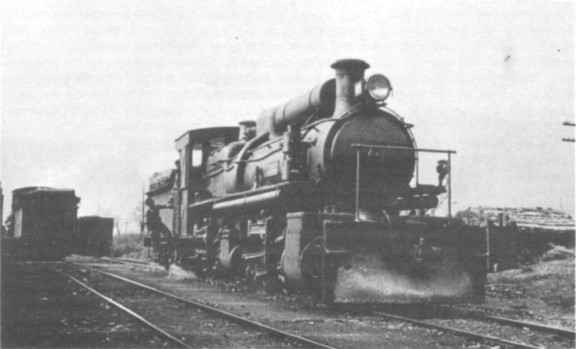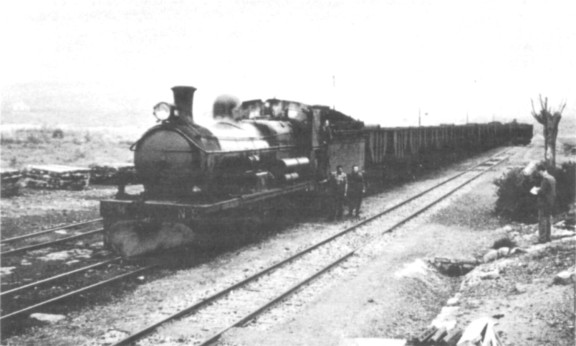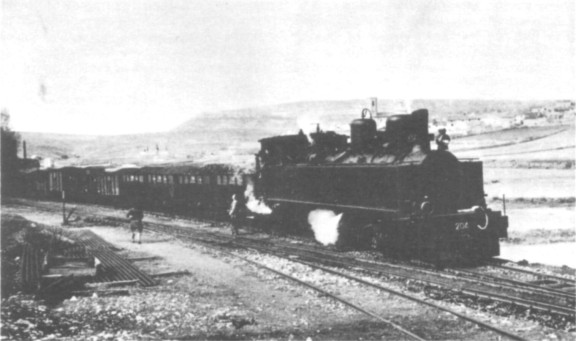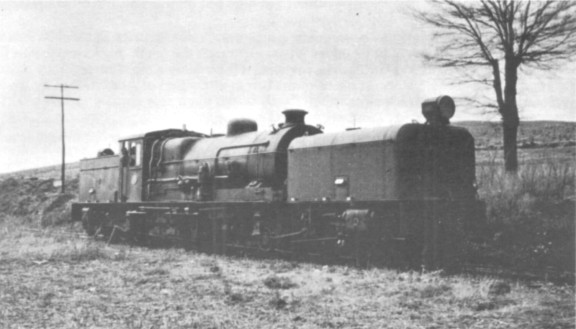VALENCIA TO ZARAGOZA
BY NARROW GAUGE
This article describes journeys made in April 1961 and the train times and statements, etc. refer to that date. Readers should note that the Utrillas Railway was closed to all traffic on 1st January 1967, whilst Henschel Bo-Bo diesels work most of the trains on the southern section of the Sierra Menera Railway. Further details of the two railways may be found in Pocket Books ES and SP. - Hon. Eds.
The normal traveller between Valencia and Zaragoza would journey over the former Central of Aragon Railway, which now forms part of the 5ft 6in gauge system of the Spanish National Railways (RENFE). The only really practicable service is offered thrice weekly by the second class TAF (Tren Automotor Fiat) diesel unit, which takes nearly seven hours to cover the 350km, with twelve intermediate stops. In contrast, the daily correo (mail) train takes 11¾ hours and the daily "MV" (Goods/Passenger) takes 18¾ hours, the former with fifty-seven intermediate stops! Although it is impossible to travel from Valencia to Zaragoza throughout by narrow gauge, in 1961 there were two long private railways whose metre gauge tracks covered most of the distance, although only one had a public passenger service.
Travelling from Valencia, only the absolute fanatic would increase his narrow gauge mileage by riding on the Valencian suburban electric railway to Rafaelbuñol (12km), and then walking the mile or so to the parallel RENFE line and catching a train on to Sagunto. For the purpose of this article, we will allow the 25km between Valencia and Sagunto to be covered by broad gauge! In fact, there is a choice of routes, as both the former Central of Aragon and the ex−Norte main line to Barcelona run parallel between these points. Curiously, the Central of Aragon has a terminal station at Sagunto and passenger trains from Valencia have to reverse to continue on to Zaragoza.
The first section of our narrow gauge journey was made over the purely industrial line operated by the Compañía Minera de Sierra Menera. This railway exists to bring down ore from the mines beyond Teruel to the Altos Hornos de Vizcaya steelworks, situated on the coast at Puerto de Sagunto. Between Sagunto RENFE and Puerto de Sagunto a passenger service is operated by the steelworks, using their own 5ft 6in gauge 4−wheel coaches hauled by an electric locomotive. Fares are very cheap, the ticket being in the form of a receipt for a donation to the AHV Sports & Social Club! This service operates irregularly to suit the manpower needs of the works, but is by no means restricted to employees only.
Within the works, shunting is performed by a most interesting variety of metre gauge tank engines, some of which have been obtained second-hand from minor passenger railways, such as the Alcoy-Gandia and the Valencian Suburban. For purely internal work locomotives belonging to the AHV company are used, but within the premises is the works and running shed of the Sierra Menera Railway whose tank engines handle the. actual formation and disposal of the ore trains. The principal SM locomotive class in 1961 consisted of sixteen North British 4−8−0’s built between 1906 and 1913, which were responsible for main line working between Sagunto and Puerto de Escandón.

Sierra Menera 2-6-2+2-6-2 Garratt 502 (Euskalduna 190 of 1930) - an oil burner at Puerto on 6th April 1961.

Sierra Menera 4-8-0 No. 5 YSIDORO (North British, Atlas Works 17403 of 1906) at Barracas on 6th April 1961 working the 09.30 empties from Sagunto back to the mines.
When we wrote for permission to visit the SM shed and then travel up the line on a train of empty ore wagons the reply agreed to the shed visit only. However, a visit to the office on arrival clarified the matter and it was agreed that a coach would be attached to the 09.30 departure the following morning. We arrived in good time and the train left promptly, hauled by 4−8−0 No.5 YSIDORO. Our 4−wheel coach was a former inspection saloon, equipped with a table and comfortable armchairs, and for company we had the brakesmen (for the descending train). They were delighted to find that a coach had been put on and that we were amenable to their company, as normally they have to travel uncomfortably perched on the ore wagons, We soon left the steelworks behind and, climbing steadily, crossed the RENFE Valencia to Barcelona main line on the first stage of our journey up into the mountains.
The company working book is a wonderful document, showing the complete timings for the service, with trains leaving each end of the line every 2 hours 24 minutes throughout the day. We were assured, however, by our companions that such an intensive service had never actually been operated, and at the time of our trip about three through trains in each direction daily sufficed to meet the needs of the steelworks.
The line is, of course, single track, and at the first passing point we had to wait about thirty minutes for the descending train. The railway runs through extremely barren and sparsely populated terrain, and we travelled many miles without seeing any signs of cultivation or human habitation. For much of the distance the SM runs within sight of the RENFE Valencia to Zaragoza line and during a water stop we hurried across to photograph a 1961-built RENFE Garratt hauling a freight train. Our driver then set off in hot pursuit, and to out delight we slowly overhauled ‘big brother’, overtaking him at a point where both lines crossed a ravine on separate viaducts. But our triumph was short lived, as on the level the Garratt soon drew away and was seen no more.
The working book allows 6 hours 43 minutes for the 130km between Sagunto and El Puerto de Escandón (the word "Puerto" here relates to a mountain pass, not a port) but only 5 hours 12 minutes in the reverse direction. The railway climbs continually to Puerto, then drops slightly to Teruel, before a final climb to the mines at Ojos Negros. During the Spanish Civil War there was much bitter fighting around Teruel, and for a long time the opposite ends of the railway were in the possession of opposing forces! The highest point reached, at Collado de las Fuentecillas, is 4107ft above sea level.
El Puerto de Escandón turned out to be a desolate spot, where an impressive layout of sidings enables trains to be divided. Our brakesmen left us to start their day’s work on the descending train, and we were joined by another group returning "on the cushions" to Ojos Negros. The load was increased considerably and our 4−8−0 replaced by a 0−6−6−0 Mallet and a 2−6−2+2−6−2 Garratt. The SM owns four of the former type, built by North British in 1909 and 1911, and two of the latter type, Spanish built in 1930. After the couplings had tightened all along the train, our coach started with a tremendous jerk that sent the armchairs sliding across the floor! Behind our two powerful locomotives we made good speed to Ojos Negros covering the remaining 75km in the scheduled three hours.
Darkness fell an hour or so before we reached the mines, but our saloon was illuminated by the lanterns of the brakesmen. On arrival at Ojos Negros, about an hour late, we were met by an employee who took us to the company’s resthouse for the night. After breakfast next morning we were collected by an official in a Land Rover and taken to the loco shed and then to the mines. Unfortunately, it was a very wet day, but none the less we enjoyed our tour of the workings, noting much British equipment, including Planet diesel locomotives and Rapier excavators. We then returned to the resthouse for lunch before being driven to the town of Calamocha. Here we caught the evening bus (a 1929 vintage Ford) to Montalban, where we spent the night before travelling down the Utrillas railway to Zaragoza.

On the Utrillas Railway at Plou, 2-6-6-0 Mallet tank 204 heads a coal train for Zaragoza on 8th April 1961.

Sierra Menera 0-6-6-0 Mallet 302 PUERTO DE ESCANDON (North British, Atlas Works 18919 of 1909) at Puerto on 6th April 1961.
The Utrillas Railway of Minas y Ferrocarriles de Utrillas a Zaragoza was built to carry coal from the mines down to Zaragoza. The passenger traffic had dwindled to one coach on alternate days in each direction and as coal traffic too was dropping off the future of the line seemed uncertain. However, only a few years ago prospects must have been better, as the railway renewed its motive power by buying eleven 2−6−6−0 Mallet compound tank engines from the Tunisian Railways. We duly arrived at Utrillas station in time for the 08.00 train (having consulted, as is sometimes necessary in Spain, a calendar as well as the timetable) and found 2−6−6−0 Mallet tank No.204 at the head of a long coal train; at the rear was one bogie composite (1st/2nd) coach. Before departure, we visited the small shed which houses a number of 60cm gauge tank engines for local work around the mines; there was a derelict 60cm gauge coach, together with six locomotives, one of which was a 0−4−0 side tank built by Black Hawthorn in 1884.
Promptly at 08.00 we were away, the coach surprisingly full, even in the first class part where a large family travelled all the way to Zaragoza, thoughtfully providing we lesser mortals in the ‘class inferior’ with music from their portable radio! There are no towns of any size en route, and a number of villages were none too near the stations bearing their names. We gradually added wagons as we progressed, until our Mallet had an extremely long train, which required assistance by 2−6−0 side tank No.6 over the adverse grade between Azuara and Valdescalera. At Utrillas the railway is 886 metres above sea level, and the line climbs steadily to its highest point at Segura (1054m). It then drops to 439m before the climb to Valdescalera (641m), finally descending to 197m at Zaragoza, 126km from Utrillas.
During the journey we passed the daily train in the opposite direction but no other traffic was noted. This was a great contrast to the SM line, where they dig out half a million tons a year from the Ojos Negros mines and estimate that at this rate there will be ore available for the next hundred years! Arrival at Zaragoza was on time at 15.35 and we were pleased to find that this, our third attempt to visit the shed of this very security minded system, met with success although no photographs were allowed. Cannibalisation was rife among the Mallets, and we learnt that only ten of the eleven bought had been put into service, the other providing spares.
So ended our three days’ journey by metre gauge from Valencia to Zaragoza. It would be possible in two days if one could be driven late at night over the rough tracks which pass for roads between Ojos Negros and Utrillas. In any case, it is certainly a more adventurous way of travelling from the fertile Valencian plains to the barren mountains of Aragon, than by the air conditioned TAF diesel railcar on the RENFE.
I should like to conclude by expressing our appreciation of the considerable trouble taken by the Sierra Menera Company to facilitate our journey, and to provide accommodation and transport for us at the mines.

No hay comentarios:
Publicar un comentario